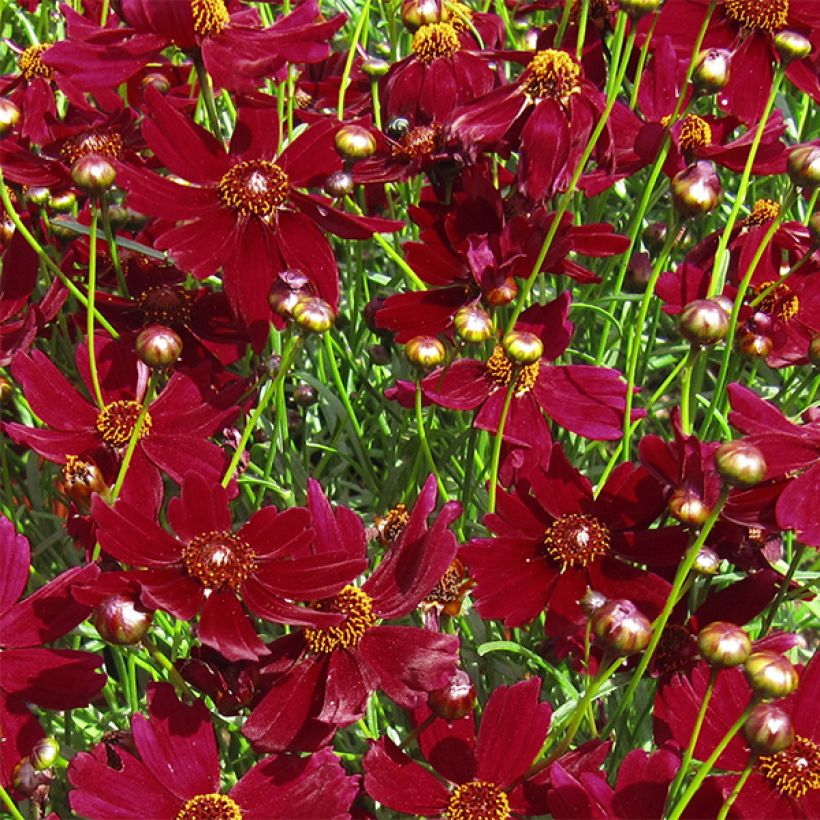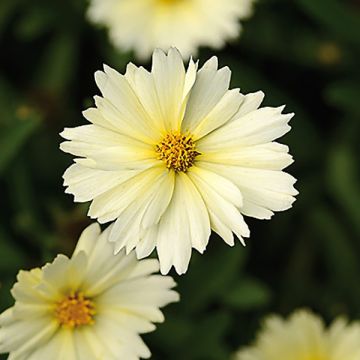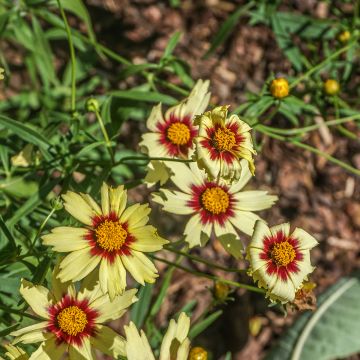

Coreopsis verticillata Ruby Red


Coreopsis verticillata Ruby Red
Coreopsis verticillata Ruby Red
Coreopsis verticilliata Ruby Red
Threadleaf Coreopsis, Whorled Coreopsis, Thread-leaved Tickseed, Needle Tickseed
Why not try an alternative variety in stock?
View all →This plant carries a 12 months recovery warranty
More information
We guarantee the quality of our plants for a full growing cycle, and will replace at our expense any plant that fails to recover under normal climatic and planting conditions.
From €5.90 for pickup delivery and €6.90 for home delivery
Express home delivery from €8.90.
Does this plant fit my garden?
Set up your Plantfit profile →
Description
Coreopsis verticillata 'Ruby Red', deserves a place in every garden. It combines a very long flowering period, with ruby red star-shaped flowers, from early summer to autumn, with a dark and contrasting foliage, made up of very thin leaves. Its compact habit, clean silhouette, undemanding nature and love for the sun make it suitable for well-exposed slopes and challenging conditions. It is also a remarkable perennial in a container and an excellent cut flower.
Coreopsis verticillata belongs to the Aster family. It is native to the plains of Central America, Mexico, and the southeastern United States. 'Ruby Red' is a cultivar selected for its rich coloured heads and compact habit. This rhizomatous herbaceous perennial with a woody base has a spreading tuft-forming habit, with numerous upright stems. It reaches a height of 50 cm (20in) with a spread of 40 cm (16in). The flowering starts as early as June and continues until autumn. The deep red flowers, measuring 3.5 cm (1in) in diameter, open from rounded buds and are arranged in whorls of 3 along the slender stems. It attracts many butterflies. The dark green deciduous foliage is composed of 6 cm (2in) long, finely divided linear leaflets. It remains healthy and attractive from spring to autumn. The plant slowly spreads through a tangle of thin, non-running rhizomes.
Coreopsis verticillata 'Ruby Red' is a versatile perennial. It will thrive in a rockery, on a sunny slope planted with wallflowers, love-in-a-mist, and wild flax, in a herbaceous border alongside Teucrium chamaedrys or x lucidrys, thyme, and cotton lavender. Its finely cut and delicate foliage will complement plants with stiffer foliage, such as daylilies, echinaceas, red hot pokers, or irises. This variety will also be the ideal companion for perennial plants, ornamental grasses, and ground cover roses. In a pot or container, this plant will flower continuously, starting from the first year. For beautiful summer blooms, it can be paired with Calamintha glandulosa and Nepeta 'Dawn to dusk' both in the ground and in a large container, with very little water. It is a lovely flower for summer bouquets, bringing a taste of sunshine indoors.
Report an error about the product description
Coreopsis verticillata Ruby Red in pictures




Flowering
Foliage
Plant habit
Botanical data
Coreopsis
verticilliata
Ruby Red
Asteraceae
Threadleaf Coreopsis, Whorled Coreopsis, Thread-leaved Tickseed, Needle Tickseed
Cultivar or hybrid
Other Coreopsis - Tickseed
Planting and care
The 'Ruby Red' Coreopsis is a hardy, low-maintenance plant resistant to diseases. It grows best in sunny spots with well-drained soil. It can adapt to different soil types, from rich and loose to poor, rocky, and sandy. It is also tolerant of drought. This plant is easy to care for, making it an excellent choice for novice gardeners. To keep your plants beautiful and healthy, divide the shrub every 2 to 3 years in the spring. Also, remove faded flowers, especially at the end of August, to encourage reblooming.
Planting period
Intended location
Care
-
, onOrder confirmed
Reply from on Promesse de fleurs
Summer flowering perennials
Haven't found what you were looking for?
Hardiness is the lowest winter temperature a plant can endure without suffering serious damage or even dying. However, hardiness is affected by location (a sheltered area, such as a patio), protection (winter cover) and soil type (hardiness is improved by well-drained soil).

Photo Sharing Terms & Conditions
In order to encourage gardeners to interact and share their experiences, Promesse de fleurs offers various media enabling content to be uploaded onto its Site - in particular via the ‘Photo sharing’ module.
The User agrees to refrain from:
- Posting any content that is illegal, prejudicial, insulting, racist, inciteful to hatred, revisionist, contrary to public decency, that infringes on privacy or on the privacy rights of third parties, in particular the publicity rights of persons and goods, intellectual property rights, or the right to privacy.
- Submitting content on behalf of a third party;
- Impersonate the identity of a third party and/or publish any personal information about a third party;
In general, the User undertakes to refrain from any unethical behaviour.
All Content (in particular text, comments, files, images, photos, videos, creative works, etc.), which may be subject to property or intellectual property rights, image or other private rights, shall remain the property of the User, subject to the limited rights granted by the terms of the licence granted by Promesse de fleurs as stated below. Users are at liberty to publish or not to publish such Content on the Site, notably via the ‘Photo Sharing’ facility, and accept that this Content shall be made public and freely accessible, notably on the Internet.
Users further acknowledge, undertake to have ,and guarantee that they hold all necessary rights and permissions to publish such material on the Site, in particular with regard to the legislation in force pertaining to any privacy, property, intellectual property, image, or contractual rights, or rights of any other nature. By publishing such Content on the Site, Users acknowledge accepting full liability as publishers of the Content within the meaning of the law, and grant Promesse de fleurs, free of charge, an inclusive, worldwide licence for the said Content for the entire duration of its publication, including all reproduction, representation, up/downloading, displaying, performing, transmission, and storage rights.
Users also grant permission for their name to be linked to the Content and accept that this link may not always be made available.
By engaging in posting material, Users consent to their Content becoming automatically accessible on the Internet, in particular on other sites and/or blogs and/or web pages of the Promesse de fleurs site, including in particular social pages and the Promesse de fleurs catalogue.
Users may secure the removal of entrusted content free of charge by issuing a simple request via our contact form.
The flowering period indicated on our website applies to countries and regions located in USDA zone 8 (France, the United Kingdom, Ireland, the Netherlands, etc.)
It will vary according to where you live:
- In zones 9 to 10 (Italy, Spain, Greece, etc.), flowering will occur about 2 to 4 weeks earlier.
- In zones 6 to 7 (Germany, Poland, Slovenia, and lower mountainous regions), flowering will be delayed by 2 to 3 weeks.
- In zone 5 (Central Europe, Scandinavia), blooming will be delayed by 3 to 5 weeks.
In temperate climates, pruning of spring-flowering shrubs (forsythia, spireas, etc.) should be done just after flowering.
Pruning of summer-flowering shrubs (Indian Lilac, Perovskia, etc.) can be done in winter or spring.
In cold regions as well as with frost-sensitive plants, avoid pruning too early when severe frosts may still occur.
The planting period indicated on our website applies to countries and regions located in USDA zone 8 (France, United Kingdom, Ireland, Netherlands).
It will vary according to where you live:
- In Mediterranean zones (Marseille, Madrid, Milan, etc.), autumn and winter are the best planting periods.
- In continental zones (Strasbourg, Munich, Vienna, etc.), delay planting by 2 to 3 weeks in spring and bring it forward by 2 to 4 weeks in autumn.
- In mountainous regions (the Alps, Pyrenees, Carpathians, etc.), it is best to plant in late spring (May-June) or late summer (August-September).
The harvesting period indicated on our website applies to countries and regions in USDA zone 8 (France, England, Ireland, the Netherlands).
In colder areas (Scandinavia, Poland, Austria...) fruit and vegetable harvests are likely to be delayed by 3-4 weeks.
In warmer areas (Italy, Spain, Greece, etc.), harvesting will probably take place earlier, depending on weather conditions.
The sowing periods indicated on our website apply to countries and regions within USDA Zone 8 (France, UK, Ireland, Netherlands).
In colder areas (Scandinavia, Poland, Austria...), delay any outdoor sowing by 3-4 weeks, or sow under glass.
In warmer climes (Italy, Spain, Greece, etc.), bring outdoor sowing forward by a few weeks.




























































